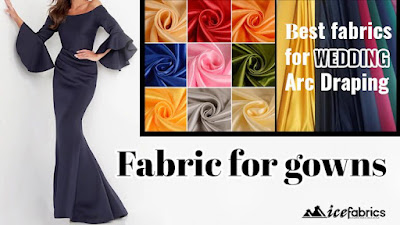Fabrics for gown weddings are produced using a gigantic scope of textures and the sort of texture utilized will decide how the dress will hang. It is vital to pick a texture that will suit you, is reasonable for the season, and is one that you truly like and will be agreeable to wear. A few textures will grip your figure while others will more pardon. Assuming you are intending to get hitched in the mid-year or in a tropical area, you will likely need to pick a lighter texture with the goal that you don't over warm or get weighed down. Clearly, assuming your wedding will happen during the colder months, a more significant texture may be more proper.
Here is a
helpful manual for the absolute most well-known Fabrics for Gowns used
for weddings.
Glossy
silk:
Extremely
well known for wedding gowns, this texture is smooth and sparkly, comes
in various loads, and can be utilized in various styles. It has a delicate wrap
when worn and familiar styles for glossy silk gowns are ballgown,
A-line, realm, and section.
Chiffon:
A delicate,
sheer lightweight texture that hangs delightfully. It is frequently utilized
for overskirts or in layered gowns. Famous styles incorporate domain and
ballgown.
Fabric:
This is a
lightweight firm texture that holds its shape all around well. The kind of
texture is utilized in full evaded outfits and organized dresses. Styles that
frequently use fabric incorporate ballgown, A-line, and segment.
Velvet:
Velvet is a
delightfully delicate finished texture yet it is genuinely weighty, in spite of
the fact that it arrives in an assortment of loads and thicknesses. It offers a
delicate wrap and is best utilized in styles like the section, ballgown, and
A-line.
Charmeuse:
This texture
is like glossy silk, be that as it may, it is milder and lighter. It makes a
streaming, floaty outfit and is best utilized in styles that exploit these
properties like realm and mermaid.
Duchess
silk:
Frequently
called 'marriage silk', this is a medium to significant burden texture which is
exceptionally lustrous. It is genuinely firm and is routinely utilized in
additional customized styles or as a base for different embellishments.
Tulle:
This is a
kind of netting that is exceptionally lightweight and is fundamentally utilized
in underskirts to give a full skirt. There are gentler variants of tulle which
are utilized for cover. It comes in various degrees of firmness so it very well
may be utilized in various conditions.
The style of
your dress will frequently direct which Fabrics are best for Gowns making
used for weddings architects will cautiously pick textures that will upgrade
their plans. Observing the right wedding outfit is likely probably the greatest
choice you will at any point make and obviously you need to settle on the ideal
decision, so having a touch of data on a portion of the sorts of texture
accessible may assist you with pursuing that decision.

Comments
Post a Comment